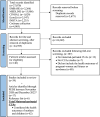A Systematic Review of Methods and Practice for Integrating Maternal, Fetal, and Child Health Outcomes, and Family Spillover Effects into Cost-Utility Analyses
- PMID: 38819718
- PMCID: PMC11249496
- DOI: 10.1007/s40273-024-01397-5
A Systematic Review of Methods and Practice for Integrating Maternal, Fetal, and Child Health Outcomes, and Family Spillover Effects into Cost-Utility Analyses
Abstract
Background: Maternal-perinatal interventions delivered during pregnancy or childbirth have unique characteristics that impact the health-related quality of life (HRQoL) of the mother, fetus, and newborn child. However, maternal-perinatal cost-utility analyses (CUAs) often only consider either maternal or child health outcomes. Challenges include, but are not limited to, measuring fetal, newborn, and infant health outcomes, and assessing their impact on maternal HRQoL. It is also important to recognize the impact of maternal-perinatal health on family members' HRQoL (i.e., family spillover effects) and to incorporate these effects in maternal-perinatal CUAs.
Objective: The aim was to systematically review the methods used to include health outcomes of pregnant women, fetuses, and children and to incorporate family spillover effects in maternal-perinatal CUAs.
Methods: A literature search was conducted in Medline, Embase, EconLit, Cochrane Collection, Cumulative Index to Nursing and Allied Health Literature (CINAHL), International Network of Agencies for Health Technology Assessment (INAHTA), and the Pediatric Economic Database Evaluation (PEDE) databases from inception to 2020 to identify maternal-perinatal CUAs that included health outcomes for pregnant women, fetuses, and/or children. The search was updated to December 2022 using PEDE. Data describing how the health outcomes of mothers, fetuses, and children were measured, incorporated, and reported along with the data on family spillover effects were extracted.
Results: Out of 174 maternal-perinatal CUAs identified, 62 considered the health outcomes of pregnant women, and children. Among the 54 quality-adjusted life year (QALY)-based CUAs, 12 included fetal health outcomes, the impact of fetal loss on mothers' HRQoL, and the impact of neonatal demise on mothers' HRQoL. Four studies considered fetal health outcomes and the effects of fetal loss on mothers' HRQoL. One study included fetal health outcomes and the impact of neonatal demise on maternal HRQoL. Furthermore, six studies considered the impact of neonatal demise on maternal HRQoL, while four included fetal health outcomes. One study included the impact of fetal loss on maternal HRQoL. The remaining 26 only included the health outcomes of pregnant women and children. Among the eight disability-adjusted life year (DALY)-based CUAs, two measured fetal health outcomes. Out of 174 studies, only one study included family spillover effects. The most common measurement approach was to measure the health outcomes of pregnant women and children separately. Various approaches were used to assess fetal losses in terms of QALYs or DALYs and their impact on HRQoL of mothers. The most common integration approach was to sum the QALYs or DALYs for pregnant women and children. Most studies reported combined QALYs and incremental QALYs, or DALYs and incremental DALYs, at the family level for pregnant women and children.
Conclusions: Approximately one-third of maternal-perinatal CUAs included the health outcomes of pregnant women, fetuses, and/or children. Future CUAs of maternal-perinatal interventions, conducted from a societal perspective, should aim to incorporate health outcomes for mothers, fetuses, and children when appropriate. The various approaches used within these CUAs highlight the need for standardized measurement and integration methods, potentially leading to rigorous and standardized inclusion practices, providing higher-quality evidence to better inform decision-makers about the costs and benefits of maternal-perinatal interventions. Health Technology Assessment agencies may consider providing guidance for interventions affecting future lives in future updates.
© 2024. The Author(s).
Conflict of interest statement
E.A. Yeh has received research funding from NMSS, CMSC, CIHR, NIH, OIRM, SCN, CBMH Chase an Idea, SickKids Foundation, Rare Diseases Foundation, MS Scientific Foundation, McLaughlin Centre, Leong Center, and Peterson Foundation; investigator- initiated research funding from Biogen; scientific advisory funding from Hoffman-LaRoche; and speaker honoraria from Biogen, Saudi Epilepsy Society, NYU, MS-ATL, ACRS, PRIME, and CNPS. WJU has received funding from Broadstreet HE Inc. RL and EP declare that they have no conflict of interest.
Figures
Similar articles
-
A Systematic Review of Methods Used by Pediatric Cost-Utility Analyses to Include Family Spillover Effects.Pharmacoeconomics. 2024 Feb;42(2):199-217. doi: 10.1007/s40273-023-01331-1. Epub 2023 Nov 9. Pharmacoeconomics. 2024. PMID: 37945777 Free PMC article.
-
How are maternal and fetal outcomes incorporated when measuring benefits of interventions in pregnancy? Findings from a systematic review of cost-utility analyses.Health Qual Life Outcomes. 2024 Sep 11;22(1):75. doi: 10.1186/s12955-024-02293-4. Health Qual Life Outcomes. 2024. PMID: 39256866 Free PMC article.
-
Family Spillover Effects in Pediatric Cost-Utility Analyses.Appl Health Econ Health Policy. 2019 Apr;17(2):163-174. doi: 10.1007/s40258-018-0436-0. Appl Health Econ Health Policy. 2019. PMID: 30350218 Review.
-
The future of Cochrane Neonatal.Early Hum Dev. 2020 Nov;150:105191. doi: 10.1016/j.earlhumdev.2020.105191. Epub 2020 Sep 12. Early Hum Dev. 2020. PMID: 33036834
-
Community-based maternal and newborn educational care packages for improving neonatal health and survival in low- and middle-income countries.Cochrane Database Syst Rev. 2019 Nov 5;2019(11):CD007647. doi: 10.1002/14651858.CD007647.pub2. Cochrane Database Syst Rev. 2019. PMID: 31686427 Free PMC article.
Cited by
-
Health economic evaluations of perinatal complications with conflicting maternal-fetal interests: a scoping review protocol.BMJ Open. 2025 Jul 6;15(7):e091521. doi: 10.1136/bmjopen-2024-091521. BMJ Open. 2025. PMID: 40623759 Free PMC article.
References
Publication types
MeSH terms
LinkOut - more resources
Full Text Sources


